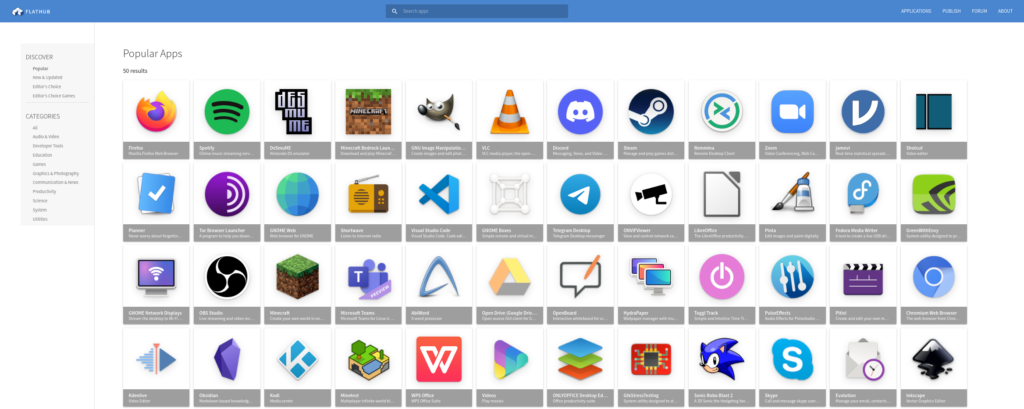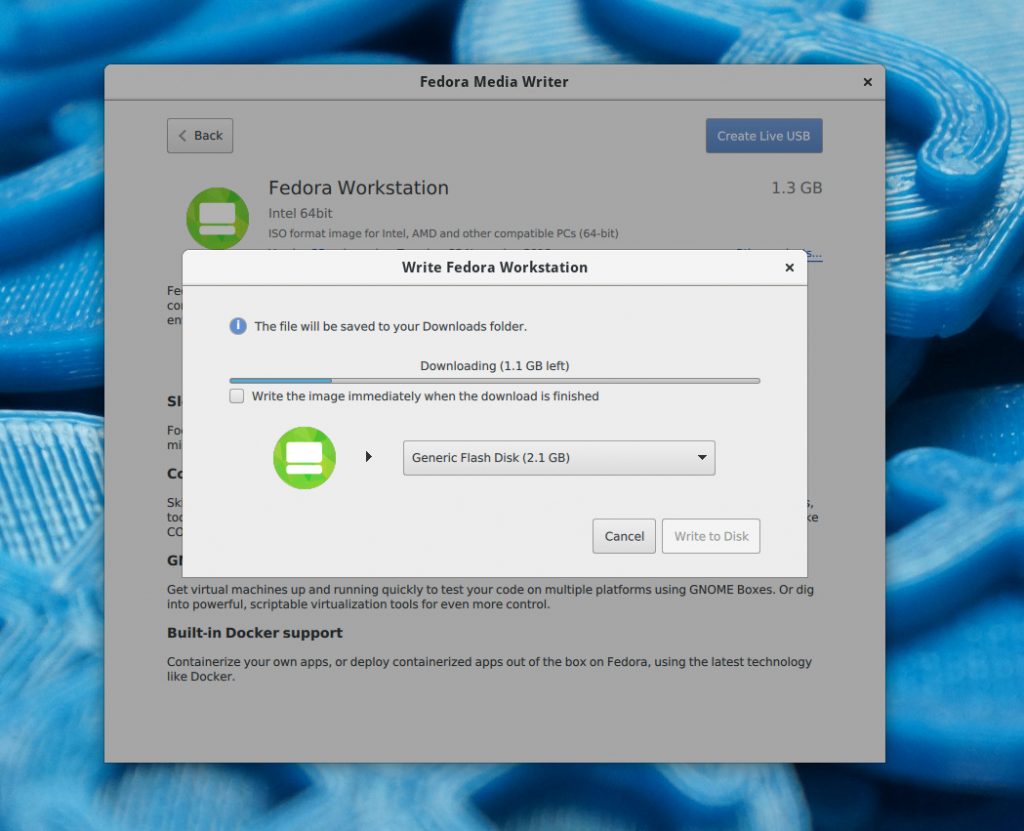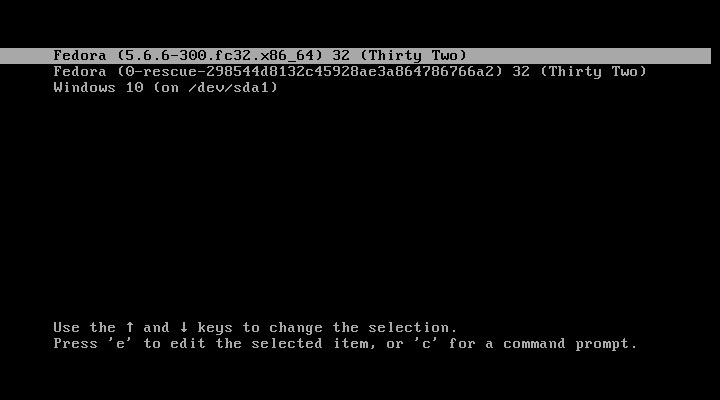Over the past couple of years, interest in Linux on the desktop has slowly increased. While running any Linux distribution on a personal computer is still uncommon, an increasing amount of people have heard of it. Thus, it would be good to talk about the steps that it takes, in case you’re interested in trying another operating system. Today we’ll talk about migrating to Fedora Linux.
A primary goal of this article is to also dispel some myths about changing your operating system. There is a tendency amongst niche audiences to over-promise their preferred product, and it would be disingenuous to claim that anybody can install Fedora Linux today.
As to why you might want to migrate to Fedora Linux, that’s a bit beyond the scope of this article. But if this is the first time you hear about Fedora, then feel free to read here Fedora’s mission statement: Freedom, Friends, Features, and First.
Migrating applications
The core of using your computer, is the things that it allows you to do: Work, study, play or relax, can all be supported by computer applications. Your operating system is as good as its ability is to run those applications. In some sense, running an operating system like Fedora Linux is simply a means to an end. There are certainly ways how Fedora can help, but it’s always in a supporting role.
That is also where the biggest hurdle lies: Linux has its own application ecosystem and that ecosystem is not compatible with other ecosystems. The biggest factor on whether you can or should give Fedora Linux a try, is in your personal selection of applications.
MoSCoW of applications
A MoSCoW is a technique to make plans, focusing on priorities and requirements. It would be good to make a list of applications, ranked by their importance to you. With that you can see if migrating to Fedora Linux is worthwhile, and if there are hurdles.
Must have
These applications are essential. You’ll not be able to keep a job, maintain a healthy social live, or finish an education without these applications.
Common examples would be Adobe Photoshop for graphic designers, SolidWorks for industrial engineers, Microsoft Office for accountants, the LockDown Browser for students, or Docker for software developers.
Should have
You use these applications daily, for things like browsing the internet, watching series, or gaming with friends. These applications can be very important, but missing out on one will not have ill consequences.
Common examples would be Google Chrome, video-games like Fortnite, Minecraft or Counter Strike, Zoom, or VS Code.
Could have
These applications would be nice to have, but they are in no way important. You could do without for a long period of time, or you could easily compromise.
Common examples would be a music player, a simple text editor for your Christmas letters, or a utility to rip YouTube videos.
Won’t have
What will you never miss? What applications do you have installed, but never touched? You don’t have to care about Fedora Linux’ compatibility if you don’t use them anyway.
Common examples include that touchpad-configuration utility, or the Help tools generously provided by your computer manufacturer.
MoSCoW of compromises
If you have a clear idea of what you use your computer for, it’s good to take a hard look at the list and see what can be done before migrating to Fedora Linux.
Must have
This is the make-or-break category. You’ll have to see if all these applications have a Linux version. Preferably a Fedora or Red Hat specific version. If not, then it’s likely better to stop right here. It’s not reasonable to migrate to Fedora Linux if you’re in any way dependent on certain applications.
Second, you could make an economic calculation. Especially in business settings, you can look into the costs of switching to Fedora as an investment and you can do a cost benefit analysis. Perhaps you should buy a new camera that has Linux support, but you might save out on operational costs for your current hardware.
The last cause of action, is to see how you can remove this dependency in the future. Having many ‘must-have’ applications puts you in a vendor-lock which could negatively impact you. Companies can over-charge you for example, or they can force you into a product-tying ecosystem. Keep this list small, even if you’ll never run Linux on a desktop computer.
Should have
Here, you have more leeway in doing things. After all, you won’t get hungry if an application is unreliable. First, see if there is a Linux version. A native Linux version will generally be more reliable then any other solution.
If not, then you can start looking for alternatives. Some websites like https://alternativeto.net/ allow you to search for Linux-compatible tools. Also, keep in mind that you’re not necessarily looking for a certain brand product. You can watch a film with a variety of applications. Some of these alternative applications are included by default with Fedora Linux.

Flathub makes it easy to install many FLOSS and non-free applications on Fedora Linux.
This is also where you can look into compatibility tools like Wine. While it’s fairly technical to set up properly, it is a way of making many Windows-only applications functional on Fedora Linux. For video games, there is a dedicated article about Gaming on Fedora Linux.
Do consider Wine a last-ditch effort though, and don’t plan your Fedora migration around it. It’s a great tool, but people also tend to oversell it’s value. Without commercial support by Valve or Code Weavers, your changes are limited.
If all these solutions seem ill-fated, then you might have a single application that you can’t use, but which should not negatively impact your life. Keep in mind that if the list of unsupported applications becomes too large, you might still not want to move to Linux. Fedora should empower you to do what you want, and accepting that Fedora Linux is not for you is equally valid.
Could have
For the majority of non-descriptive applications that you need occasionally, you can assume that there are multiple roads to Rome. Try the Software Center or look around on Flathub, and you’ll find applications that can help you with simple things.
We’ve now also reached the point where personal preferences come into play. Would you like to control your music from your mobile phone? That’s not supported on Fedora Workstation with GNOME, but you could use the KDE Spin of Fedora Linux which supports KDE Connect for Android.
It could also mean that you should use a browser-version of a certain application. Even major applications like Microsoft Office can be used through the web, as long as it’s limited to casual use. Same for the occasional cropping of an image; you don’t need a pirated copy of Photoshop to do that.
Won’t have
That should be easy! But fear not, although you might not be able to migrate many of your useless applications, Fedora Linux also has its own collection of beautiful applications to try and then forget about. Even better, if there are applications that you don’t need, you can always uninstall them: Your browser-choice is respected on Fedora Linux.
Trying Fedora 35
At this point you should have a pretty clear understanding about migrating to Fedora Linux, and if it’s something for you. But how to start? There are some basic steps that you can go through, trying Fedora Linux without committing to anything yet.
Virtual machine
You can run a computer on a computer! With a program like Oracle VirtualBox, you can start Fedora Linux on almost any operating system, so you can poke around without risking anything. This will allow you to look at the UI and the basic set of applications. Keep in mind that a virtual machine is not very good for performance so you can’t make any educated guesses about how well Linux will run on your computer.

Fedora Linux running inside VirtualBox
To use VirtualBox, you can head over to their website and take a look at their documentation and installation instruction for your machine. We even have an older Magazine article about installing Fedora Linux inside VirtualBox. The only thing I must warn you for, is that VirtualBox is not FLOSS. There are some legal trapdoors so be careful: Use it for personal, non-commercial, purposes only.
Live-boot environment
Another way of trying Fedora Linux, is by booting it off a USB Stick. You can prepare a USB Stick with the Fedora Media Writer, so that it can start Fedora Linux the moment you restart the computer. You can then try Fedora Linux and use the browser, media applications, and basic office applications.

Fedora Media Writer
This is also the best moment to see if all your hardware is properly supported. Go into the setting panel and see if all the audio devices are visible. Also check your wireless options. The only hardware that will not be properly detected although it might still work, are NVidia graphics cards. This is sadly a known fact and continues source of frustration. The article about Gaming on Fedora Linux can tell you how to deal with that.
Dual-boot system
This is a side-step in migrating to Fedora Linux, because nobody says that you can’t use two different systems. During the installation process of Fedora Linux, you can tell the system how to partition your hard-disks. You can install Fedora Linux next to Windows 11 if you want to.
Image curtesy to TecMint. Their website has a full guide.
The only risk to keep in mind, is that while Fedora Linux likes to play nice with other systems, nothing forces other systems to be equally generous. You will not be the first person to lose access to their Linux installation because some other operating system wipes the start-up configuration.
Summary
You likely already know if there are any specific applications that will stop you from migrating to Fedora Linux. This is not bad, and simply thinking about possible alternatives makes you a more educated computer user. As elaborated earlier, it’s about empowering you.
If all the roadblocks are cleared, and you’ve tried Fedora Linux in a controlled environment, then this is the point where ideas can be put into action. Head over to the official documentation for the installation guide.
Care to comment? Feel free to tell us why you use Fedora Linux or why not, and tell us how you managed to deal with the inevitable application-ecosystem incompatibility. Do you use Wine a lot? Have you changed your software habits?







Hans
Good article. I use Fedora for a few years. When I need Windows I install it on Boxes. Better performance then Vbox or VMware. Using Linux Fedore gives you a quicker and reliable machine. This is for me necessary.
Michael
Is this really a good article though? The first half of this long article just says “ you shouldn’t use Linux if there’s not a native version of the application you want to use” which isn’t even true, wine layer runs windows application beautifully
Andrew W, Oxford
I’d add an application which I regard as a must have: Adobe Reader DC. Critically, this application allows PDFs to be filled out (as in completing a form) and signed. Given how that PDFs (used as forms) are so now so pervasive, it is an inadequacy of Linux at this time,
Adobe hasn’t been releasing their application on Linux, and the alternatives are a bit pants in this regard – notably Libra Office and its provision for filling out PDFs. None of the other PDF tools – as far as I know – have adequate provision.
Thankfully, there is a very good description of compiling Abobe Reader DC (using Wine) here which also works on F35: https://linuxhint.com/install-adobe-reader-fedora-linux/
Obviously, the above is my personal opinion!! : – )
Peter Braet
Installing Acrobat DC reader from snap works indeed, it pulls in a lot of Wine stuff, but getting an official signature from the eID in this Wine that comes with it does not work! The only reason why I still have an old Windows laptop too: adding an official signature to a document. Something that doesn’t work in Linux because Adobe Acrobat only. Well, this Wine installs the 32-bit version of Acrobat. Gonna delete it all, no Windows-shit in my Linux. Wine is crap. Petty, really the only thing that cannot be done in Linux: adding an official signature from an ID-card to a document. Essential! Only Login on official sites with the e-ID works, but document signing is missing. Should work if you want to have average users in Fedora or other Linux. Everybody needs it. Mandatory!
Gregory Bartholomew
https://ask.libreoffice.org/t/can-i-make-a-pdf-consent-form-that-customers-can-fill-in/1887
Max Mustermann
Great, finally someone who knows how to sign documents with an eID! I have a German eID card and I can log into government websites with it, but I struggle to sign documents with that card, even when using windows. Can you please give any reference of how to do that? I just know about the sign-me service of the bundesdruckerei, which is completely online and should work with any operating system. But using a real eID card to sign documents offline would be nice. Thanks a lot!
Peter Braet
https://eid.belgium.be/en/faq/how-do-i-set-digital-signature-acrobat-reader-dc
Max Mustermann
Thanks Peter Braet, seems like the Belgian ID is more powerful then the German. I know the German could load a signature in principle, but it is not preinstalled and all providers for loading a signature have left the market. Such a waste 🙁
Anyways, LibreOffice can supposedly sign arbitrary pdf files: https://linuxkamarada.com/en/2020/03/13/signing-odf-and-pdf-documents-with-libreoffice/
It uses the firefox or chromium certificate store, so you would have to load the certificate there first. But that seems to be possible. Unfortunately I cannot test this 🙁
Sean O
You might look at Okular, I use it for very large pdf files since it works a LOT better then evince for those. It has some handy features in it. I read a review about forms and someone said it was ‘buggy’ in 2018, but here is an article from 2015.
https://www.marnel.net/2015/10/pdf-forms-and-linux/
(as always if you can reproduce a bug, you should report it.)
They also mention master pdf editor if you are really stuck, which is a 70 dollar commercial app (someone mentioned they were based out of russia)
https://code-industry.net/
Ondrej
Kudos for pointing out, that Wine should not be considered as daily-driver. It’s good to avoid it if possible. We (as community), should not recommend it if not absolutely necessary
x86inside
I have been using gnome in the main office for over 20 years. From experience I have banned wine which is too unpredictable. For applications that only exist on Windows, I opted for Windows virtualization in Fedora. It is very flexible to use, with the advantage of having a backup of Windows images, which facilitates the maintenance of this unstable system.
For hardware compatibility, there is really great progress, it’s been a long time since I had any problem installing a webcam or wifi card. For the printer, I am a good customer for HP, who actually provide the drivers for Fedora. If your computer is still under warranty, I advise you to change the hard drive, so that you just have to reinstall the original if you have to send your computer to the after-sales service.
Ben Engbers
I believe that I am using Fedora on my desktop since the beginning of Fedora! And at first glance, I can’t name any functionalities that I am really missing. I can edit texts and spreadsheets (with Libre Office), handle my mail (Thunderbird) and I can develop applications (with R, Eclipse). And there are lots of other productivity-tools like Audacity, GIMP etcetera. It is only a pitty that sometimes applications are no longer maintained and they just disappear from new distributions (I used fslint quite often ;-( ). Also some system-config tools have disappeared.
Sometimes it is is difficult to find drivers (printers, scanners, webcam). Or if you have found them, installing them can be problematic.
Usually, I just install all the upgrades without formatting my hard disk. Consequence is that eventually, after several upgrades, the desktop becomes less stable. It is only then that I do a clean install. And whats the most cumbersome then is that I have to reinstall all the dependencies.
Is it possible that as a pre-upgrade tool, you create a delta from the clean install and the current installation and that after the upgrade that delta can be executed?
Ben
Danniello
Create delta from old system – yes, it is possible, but probably not in automatic way. I mean you could very easily create list of installed packages on “old” system, for example with commands:
– list of enabled repos
– list of packages installed by user
– list of installed flatpak apps
But to use them on clean system – you will need to adjust these lists – for example remove info about versions, etc.
Sean O
The best way is to take notes of your setup while you are doing it to avoid ‘forgetting’ what you did several years later. 😛 You can do as Ben suggests or make a list of all the apps you do use. After 5 years, you end up with a fair bit of cruft from installed but no longer needed applications.
Your desktop instability MAY be caused by something caching like the file manager, and the db files need to be removed and rebuilt. But that is just a guess.
John
I take my hat off.
Thanks!
Mary Biggs
WINE has been very useful in keeping useful things running after our household simply found Windows 8 and Windows 8.1 just too unstable and too unusable. Fedora and WINE to the rescue! So, for example, Visual FoxPro 6 (vintage 1998) is still running today without problems under F35 and WINE 6.21. Similarly, going back even further, Multimedia Viewer (a Windows 3.1 application, vintage 1992!) also runs without problems.
Commentators here suggest that WINE should be avoided. My suggestion is rather different — test your WINE application before you start to rely on that application. Your mileage will vary! My experience has been always been positive.
Ryan
re: dual booting
I would recommend rather than using the same hard drive to perform a dual boot, get an external USB hard drive and install Fedora on that. Then boot off that hard drive whenever you want to run Fedora.
I successfully used this method for many years before I finally went all in on Fedora. This stops ‘other operating systems’ from trampling over your boot loader.
re: PDF readers and forms (responding to comment from Andrew W, Oxford)
Okular does a pretty decent job of filling out forms. Sometimes Adobe reader doesn’t set the borders of text boxes properly created in Okular, but otherwise it works well, I used it just this week.
Ryan
In regards to the questions at the bottom of the article:
‘Feel free to tell us why you use Fedora Linux or why not, and tell us how you managed to deal with the inevitable application-ecosystem incompatibility. Do you use Wine a lot? Have you changed your software habits?’
I use Fedora Linux and have done so since Core 1 (technically I used RedHat 9 too when I was studying). I use Fedora Linux because it is open source but also pragmatic, because it is privacy respecting, and because it is powerful. I like that I can make it what I need it to be, and that I can do pretty much everything I need to without relying on proprietary, privacy invading, data collecting software.
In terms of dealing with application ecosystem incompatibilities…for some things I use the web interface, for some things I use another application that does most of what I need or gets me the majority of the features I need and if necessary, i will use another application to get me the rest of the features. Sometimes I will use virtualisation if there is nothing that will do the job and just perform that minor task, although that is generally fairly uncommon now. For games, I use proton, and I check that the game is working well in proton using protondb first before I make a purchase.
Finally to answer the last part of the questions posed, yes I have changed my software habits to work in Fedora Linux, but mostly I don’t feel like that’s an issue, it’s fairly rare for me to feel like I’m missing out, especially as I get a lot of other awesome tools that (while you can get working with linux virtual machines and compatibility layers) don’t have an equivalent in ‘other operating systems’ like podman, and KVM, and native ruby, and native python, and development tools that are just available directly and natively in Fedora Linux. Seriously although the aforementioned ‘Linux compatibility layer’ in ‘other operating system’ is getting fairly decent, it’s still not comparable to running Fedora Linux on bare metal.
MSoza
At first, I used windows10 with fedora 30 in dual boot, then I eliminated win10 and kept fedora (I had to repair the grub), I went to fedora 31, then 32 for upgrade and finally I opted for SSD, there I installed clean f32, then pass for upgrade to 34 and here I am, I will make my next jump to 36 when absolutely necessary, I am lazy to upgrade for each launch, so I jump two by two, by the way I use the KDE spin with x11, wayland is green and gnome really think it has gone the wrong direction with 40.
mint
Fedora Make life easy for new people in the field … Playing an MP4 file needs a bachelor’s degree Not everyone is an engineer. Where to download a package of codec
Elazar
I was a “technology expert” and thought ‘I have to know about this Linux thing…” And picked Fedora because of Red Hat. Installed it in a partition and never used it. I booted my M$ Windows one morning and it was broken, so I booted to Linux, opened up Chrome and started working. Thought to myself ‘I have to reinstall Windows’ but on Sunday I wanted to do anything but sit on a computer. Long story short, never installed Windows again. SSD, 16 gigs of ram, good AMD processor, have had the same PC for almost 10 years. We use Google Apps, I just format my PC and do fresh latest Fedora I stall each new version and run a script I have tailored to install all I want. Use Resilio for music and few files I use on my phone and laptop, all syncs up. Love my digital life. When I read the news and hear about malware, ransomware, virus and all that is like hearing about countries far away that have been at war forever, and think ‘I am sad it happens to them, glad it’s not me’ 🙂
milvusmilvus
What do you use to sync your phone?
milvusmilvus
Some of the different ways to try out Fedora or to run it parallel to another operating system have been described here. For example via the bootloader or a USB harddisk.
I myself have found another possibility, which is not mentioned here yet.
I have my work home office PC running Windows and Fedora. Windows is used for work and Fedora for private use. I have installed a second hard disk for Fedora in the computer. This second private is, just like the first hard disk, to activate or deactivate via a switch. So now I only have to activate the right hard disk before booting, and I have both systems completely and safely separated from each other.
For me, this is the safest system without touching the original hard drive and still having everything in one enclosure without having to watch out for external hard drives.
The hardware with the switches to be installed in a normal CD-ROM slot should be found under the keywords “Drive Switcher” or “HDD Power Control Switch”.
In the end, it’s the same solution as with a USB hard disk, but everything is installed internally and the unused disk is completely deactivated because it has no power.
Willdrick
Just a quick tip/correction, you can definetly control the music (and much more) from your mobile phone while using Fedora Workstation (GNOME).
Instead of KDE Connect, you just need “GSConnect” extension from gnome extensions.
Anon Ymous
I gotta say, I have a new dell xps laptop with only a thunderbolt port on it. Fedora 35 is IMPRESSIVE- it ran the smoothest on my laptop, it actually even had an extensive firmware update for my particular model. That is impressive. So anyways- Fedora 35 seems VERY capable of working with new / modern machines, which is greatly impressive in comparison to other distros. Fedora is one of the very top distros – and this is easily proven by my laptop.
Jesse Pollard
you won’t get hungry if an application is unreliable.
sure you can – if suddenly you cannot retrieve your banking information, or make proper payments on time.
Unreliability means that those things don’t necessarily happen.